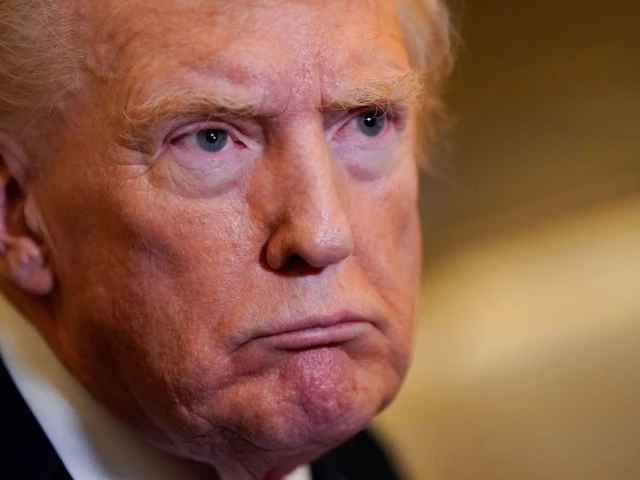Business
Who is winning global tech race? | The Express Tribune
1724844288-0/BeFunky-collage]_______-(8)1724844288-0-640x480.webp)
The Global AI Summit kicks off at the Saudi capital Riyadh, September 13, 2022. PHOTO:Twitter Al Arabiya
KARACHI:
“China is going to win the AI race.” The remark sent ripples through Silicon Valley and beyond when Jensen Huang, CEO of US chipmaking giant Nvidia, made it at an AI summit in London earlier this month. Huang, whose company dominates the global AI chip market, later softened his position, saying China is merely “nanoseconds behind America.”
But Greg Slabaugh, Professor of Computer Vision and AI at Queen Mary University of London, is convinced that China has “already won” the AI race. And he made a startling revelation to back up his claim: of all the papers presented at the 2025 International Conference on Computer Vision in Hawaii, half were authored by Chinese researchers – far outstripping the US at 17%. Factor in Chinese nationals working abroad, and the gap would widen even further.
Three years before Huang’s candid acknowledgement, the Australian Strategic Policy Institute had reported that China leads in 57 out of 64 critical technologies – from quantum sensors and AI to robotics and semiconductors – while the US maintains an edge in far fewer areas, such as biotechnology and aerospace. This marks a dramatic reversal from 2003 to 2007, when the US led in 60 of 64 technologies and China in just three. Beijing’s current dominance stems from a high-impact research ecosystem in which, in some fields, it holds something close to a near-monopoly.
This meteoric rise, especially in AI, couldn’t be stymied by US efforts to limit China’s access to advanced chips and manufacturing equipment, which were intended to maintain America’s edge in the sector. Unlike past advantages based on cheap labour or scale, China’s AI lead is structural, built on concerted strategy, coordinated investment, and an energy ecosystem optimised for massive computational growth.
The AI revolution is, at its core, a revolution of power – in both senses of the word. Training the largest data models requires a huge computing capacity, which is powered by electricity on a colossal scale. By the decade’s end, experts say, AI data centres could consume more power than some mid-sized nations. And China holds a decisive edge in this high-voltage contest. Its subsidised electricity, flexible regulation, and capacity to execute large-scale projects at rapid speed have led to the mushrooming of AI infrastructure nationwide. From data-centre clusters in Inner Mongolia to renewable-powered server farms in Sichuan, Beijing has built an energy foundation capable of sustaining AI’s exponential growth. On the contrary, US tech giants are increasingly hamstrung by a growing web of constraints. The American electricity grid is old and fragmented, creating logistical and regulatory bottlenecks. Microsoft has conceded that energy shortages are slowing the expansion of its data centre. Chinese authorities, meanwhile, have turned energy planning into a national security priority – integrating AI, cloud computing, and grid modernisation into one strategic blueprint.
While Western firms like OpenAI and Anthropic pursue closed, commercial AI models, Chinese developers have doubled down on open-weight systems – models whose trained parameters are freely available. The result has been an open-source explosion that is transforming global software development. Chinese open-source AI downloads have now surpassed those from the US, according to venture capital firm a16z. Companies such as DeepSeek, MiniMax, Z.ai, and Moonshot are releasing high-performance models at a fraction of US prices.
China’s innovation often lies not in raw capability, but in accessibility and cost efficiency. Airbnb CEO Brian Chesky recently revealed that his company had replaced OpenAI’s ChatGPT with Alibaba’s Qwen model, calling it “fast and cheap.” Chamath Palihapitiya, CEO of Social Capital, said his firm has switched to Moonshot’s Kimi K2, describing it as “way more performant” than American rivals.
Conflicting approaches are at play here. The United States, by its own admission, wants to maintain global leadership in AI to secure its economic competitiveness. China, on the other hand, pushes for democratisation of AI, promoting open cooperation, capacity building for developing nations, and an “AI for the public good.” With this approach, Beijing has flipped one of Washington’s strategic levers. American export controls – meant to slow Chinese progress by denying access to cutting-edge chips – have instead spurred Chinese firms to build leaner models that run on older hardware. “They’ve actually encouraged Chinese companies to be more resourceful,” said AI researcher Toby Walsh. “It’s exactly what happened with solar panels – constraints made them smarter and cheaper.”
The story doesn’t end there. One of the most consequential areas of Chinese dominance is remote sensing: the science of gathering data from a distance through satellites, drones, and advanced sensors. A recent global analysis of 126,000 peer-reviewed papers found that China produced nearly 47% of all remote sensing research between 2021 and 2023. The American share, which stood at 88% during the Cold War, has fallen to just 9%. The patent landscape tells the same story. Among the top 19 global patent filers in remote sensing between 2021 and 2023, Chinese institutions accounted for 62%. Why does this matter? Because remote sensing underpins nearly every next-gen technology – from self-driving cars and smart cities to climate modeling and precision agriculture. Whoever controls the sensors, data flows, and analytic algorithms effectively controls the informational foundation of modern economies.
That said, China’s leap was no accident. Since the early 2000s, Beijing has strategically targeted the field for heavy investment under national programmes like the “973 Plan,” pairing state funding with private enterprise. The result: a vast ecosystem of universities, startups, and ministries working in concert. The US, by contrast, has relied heavily on NASA and the private sector. But fragmented research funding, bureaucratic inertia, and inconsistent industrial policy have eroded its early lead. When one country produces nearly half of global output in a strategic domain, and controls most patents and funding, it is shaping the next generation of value chains.
China’s stratospheric rise extends far beyond data and algorithms. In sector after sector, Western companies find themselves being out-produced, out-priced, and out-innovated. In automobiles, Chinese brands are redefining global competition. In 2024, Chinese carmakers captured 7.4% of all passenger car sales in Europe, nearly doubling their share within a year. EV maker Leapmotor posted a staggering 7,000% jump in sales, while BYD and Chery continue their European expansion with EVs far more affordable than Western models. This is why Ford CEO Jim Farley recently issued a blunt warning: “They have enough production capacity in China to serve the entire North American market.”
The same dynamic plays out in wind power, where Chinese manufacturers like Goldwind, Envision, and Mingyang now occupy the top four global slots – pushing Western rivals Siemens Energy, GE, and Vestas down the rankings. Chinese turbines are up to 50% cheaper, thanks to economies of scale and domestic demand that dwarfs anything in Europe or the US.
Having said that, all is not lost for the West, particularly the US, which still dominates the premium end of AI, biotechnology, and aerospace. Yet Washington must rethink its approach: instead of trying to slow China’s rise through export controls and strategic containment, it should focus on large-scale investment in energy infrastructure, R&D, and education. At the same time, it needs to face the new reality.
The writer is an independent journalist with special interest in geoeconomics
Business
Japan tourism and retail stocks slide after China row

Japanese tourism and retail stocks fell on Monday after China warned its citizens not to travel to the country as Tokyo and Beijing remain locked in a row over Taiwan.
Japan’s Prime Minister Sanae Takaichi, who has been a vocal critic of China and its military activities in the region, suggested this month Tokyo could take military action if Beijing attacked Taiwan.
Shares in cosmetics company Shiseido plunged nearly 10% while department store chain Takashimaya and the owner of global fashion chain Uniqlo fell more than 5% in early trading.
China has consistently ranked among the top sources of tourists visiting Japan.
The share price falls came after the dispute between Beijing and Tokyo has deepened in recent days.
On Sunday, the Chinese government urged its citizens to reconsider studying in Japan, citing risks to their safety and a rise in crimes targeting Chinese people.
China’s Education Ministry also told students already based in Japan to closely monitor the security situation.
Last year, more than 100,000 Chinese students were enrolled in educational institutions in Japan, according to a Japanese government survey.
Also over the weekend, Chinese airlines – including China Southern Airlines, China Eastern Airlines, and Air China – offered refunds for flights to Japan.
Takaichi said in the Japanese parliament on 7 November: “If there are battleships and the use of force, no matter how you think about it, it could constitute a survival-threatening situation.”
A “survival-threatening situation” is a legal term under Japan’s 2015 security law, referring to when an armed attack on its allies presents an existential threat to Tokyo.
In such a situation, Japan’s self-defence forces can be called upon to respond to the threat.
Taiwan lies around 100km (60 miles) south of the closest Japanese island.
Beijing sees Taiwan as a breakaway province that will, eventually, be part of the country, and has not ruled out the use of force to achieve this.
But many Taiwanese consider themselves to be part of a separate nation – although most are in favour of maintaining the status quo where Taiwan neither declares independence from China nor unites with it.
Business
How my on-air ‘brain fog’ moment sparked a big debate

Zoe KleinmanTechnology editor
 BBC
BBCWhen I rather nervously shared a personal post about dealing with brain fog at work on the social network LinkedIn last week, I had no idea that it would have such an enormous impact.
It’s been viewed hundreds of thousands of times. Women have stopped me on the street to talk to me about it.
I’ve been overwhelmed by hundreds of messages from people sharing support and their own experiences of it.
Usually I cover technology news. But given the response, it felt important to talk about this as well.
“Brain fog” isn’t a medical term. But you may well know exactly what I’m talking about.
That moment when you suddenly can’t remember the word for something really obvious, or you’re mid-sentence and you lose your train of thought. It’s infuriating, and it can be embarrassing.
Where was I?
Ah yes, for me, as a woman in my 40s, it’s coincided with perimenopause – the stage in my life where my hormone levels are changing. There can of course be other neurological conditions for which brain fog can be a symptom too.
If you’re in a job where public speaking is part of what you do, it can be particularly terrifying.
“I’ve spent 30 years being professionally articulate,” wrote Janet Edgecombe, an internal communications expert.
“All of a sudden I’m forgetting the words for basic things. ‘That grey thing in the thingy that we cook chicken on’. My husband replies ‘oh, the baking tray in the oven’. Hmm. ‘Yeah, that thing’.”
 Getty Images
Getty ImagesI also heard from teachers, start-up founders having to present pitches for money to investors, women running workshops, delivering speeches – and fellow journalists trying to report live on-air, like me. But of course it can also hit mid-conversation, in a more intimate but no less frustrating way.
My post was about my decision to hold a page of notes on the BBC News at Ten. A story had broken late in the afternoon, following an already busy day, and by the time we reached 10pm, I knew I was getting tired and I could feel the brain fog.
I was going to talk about an outage that was affecting dozens of websites and apps, and I planned to use the technical jargon for it, as given by the company affected, and then explain what it actually meant.
But I just couldn’t get the phrase to stick in my head and I knew that without it, I wouldn’t manage the rest of what I needed to say.
I was reporting live from Glasgow. Like many of my professional peers, I do not have, and I’ve never had, autocue. And so, for the first time, I decided at the last minute to hold a page of notes with the offending phrase on it.
It felt to me at the time like an admission of failure. I have been trained never to use notes – unless there’s a specific legal reason why the wording of a statement, for example, has to be precise, or there are a lot of figures to remember.
Even then, I have prided myself on having a good enough short-term memory to get me through.
Using notes is discouraged in the world of public speaking. They are not permitted to anyone giving a 12-minute TED talk. The speaker is expected to memorise their speech.
Looking down the barrel of the camera and clutching that paper, live on TV, felt tough.
But around 10% of women report leaving their jobs due to menopause symptoms, according to the Fawcett Society. And research by insurance firm Royal London found that half of women going through it have considered giving up work. I don’t want to do that – and so I stuck with my solution.
To my intense relief, some people said they thought my paper looked authoritative, that they just assumed it was a breaking story and the page contained fresh information. Others asked why I hadn’t used a device instead – I suppose I thought the potential of having to fumble with a screen would feel even worse.
“Let’s start a movement: Hold your notes,” wrote Elisheva Marcus, vice president of communications at the venture capitalist firm Earlybird.
And so, the hashtag holdthenotes was born.
“Have you ever checked your testosterone levels?” menopause expert Dr Louise Newson asked me.
She says testosterone – despite its reputation for being a male hormone, and its association with sex drive and libido, is actually an essential brain chemical for both men and women, and levels fall in both genders. One of the results is brain fog.
“It’s like you’ve been drugged,” she says. “It’s really scary, a lot of people worry they’ve got dementia.”
“I remember when I had my levels done 10 years ago, and I was like ‘Thank God, at least I know why I’m feeling so awful’.”
She adds that there are studies dating back to the 1940s indicating that testosterone can improve brain function and wellbeing in women as well as men, but the randomised control studies, where participants are given either a placebo or the product itself in order to see whether it really works, have only focused on improvements to libido.
NHS-prescribed Hormone Replacement Therapy, or HRT, is traditionally a combination of oestrogen and progesterone. Testosterone is not routinely included.
Instead doctors can separately prescribe testosterone to female patients, at lower doses than given to men.
 Getty Images
Getty ImagesThere are also a myriad of menopause supplements which claim to ease symptoms including brain fog. Estimates vary but it’s a multi-billion dollar industry and its booming.
Women spend an average of £147 per year on supplements to try to alleviate their menopause symptoms, according to a survey earlier this year by the nutrition news website NutraIngredients.
“They might help a bit,” says Dr Newson.
“I do yoga every day, and that helps my brain become clear and focused, but I have a hormone deficiency, I can’t eat my way out of it, or exercise my way out of it.
“A lot of women spend a fortune trying to improve symptoms of a hormone deficiency with something else.”
Dr Joshua Chen is part of the Harvard Medical School-Massachusetts General Hospital Photobiomodulation Research Group. The team is looking at how frequencies of red light can change the mitochondria inside the brain to improve focus.
He describes it as “like a face mask, but for the brain”. It can also, he says, be applied to the Vagus nerve on the neck to reduce stress.
He has founded a company called Niraxx which markets a headband called a neuro espresso, which is designed to be worn for up to 20 minutes a day. He claims the results are instant. It has to be plugged in – there are no batteries in the device for safety reasons.
 Niraxx
NiraxxAngela Marsh is a registered nurse and a menopause coach. She says her clients often describe brain fog as feeling like they are “living life in soft focus”.
“I don’t think brain fog is taken seriously enough at all,” she says.
“Many women feel deeply unsettled by the changes they experience. They think there’s something wrong with them or they’re ‘losing it’ when in fact there’s a clear biological reason.”
As for me – well, I’ve booked a blood test to check my hormone levels. I’m going to try some red-light therapy. And you are probably going to see me holding notes a bit more often.
Business
Formula 1 tech used to improve train Wi-Fi on GWR

Laura CressTechnology reporter
 GWR
GWRA new UK-first pilot scheme is aiming to create fast and more reliable train wi-fi, using technology originally developed for Formula 1 cars.
It will see a train in the Great Western Railway fleet use a hybrid system of both signals from mobile phone masts on the ground and low earth orbit (LEO) satellites in space to create a more reliable connection.
The scheme has been developed by British tech company Motion Applied, in partnership with the transport body for Cornwall, Devon, Plymouth, Somerset and Torbay, Peninsula Transport.
The pilot will last for 60 days onboard GWR’s Intercity Express Train which runs in the South West region, having started in mid-November.
In a recent study by networking testing firm Ookla, the UK ranked 16th out of 18 major European and Asian countries for train wi-fi speed, with average download speeds at just 1.09 megabits per second, compared to Sweden’s 64.58.
Nick Fry, chairman of Motion Applied, formerly part of McLaren Group, said the issues faced in connecting to the internet from a fast moving train had “many parallels with motorsport”.
He added that by using technology originally developed for F1 cars, trains should be able to switch between ground and space-based networks such as LEO satellites to “reliably connect” without drop outs.
In the 2025 spending review, the Department of Transport secured £41m to introduce low earth orbit satellite connectivity on all mainline trains by 2030.
‘A step in the right direction’
Councillor Dan Rogerson, from the Peninsula Transport board, called the pilot a “major milestone” in its plans to modernise transport infrastructure across the South West and South Wales.
“It’s not just about passenger wi-fi,” he said. “This is about a whole new digital backbone for our transport networks”.
Bruce Williamson from the campaign group Railfuture told the BBC the scheme appeared to be “really good news”.
“We’re all increasingly connected these days, and wi-fi has become more and more of an essential service for travellers. I’m not going to hold my breath, but this is a step in the right direction.”
In May, South Western Railway launched its own, separate, “superfast” wi-fi rollout for its trains between Earlsfield and Basingstoke, using trackside poles and antennas to create a bespoke 5G rail network.

-

 Entertainment1 week ago
Entertainment1 week agoChina unveils£5.4 bn Fujian, its most advanced aircraft carrier yet
-

 Tech7 days ago
Tech7 days agoFrom waste to asset: Turning ethanol production CO₂ into jet fuel
-

 Politics1 week ago
Politics1 week agoIDF lawyers warned of possible Gaza war crimes: US intel findings
-

 Tech2 days ago
Tech2 days agoNew carbon capture method uses water and pressure to remove CO₂ from emissions at half current costs
-

 Sports1 day ago
Sports1 day agoTexas A&M officer scolds South Carolina wide receiver after touchdown; department speaks out
-
Sports1 week ago
College football winners and losers: The catch of the year saves Indiana
-

 Politics3 days ago
Politics3 days agoBritish-Pakistani honoured for transforming UK halal meat industry
-

 Business1 week ago
Business1 week agoMore than 1,000 flights cancelled as US air traffic cuts enter second day














